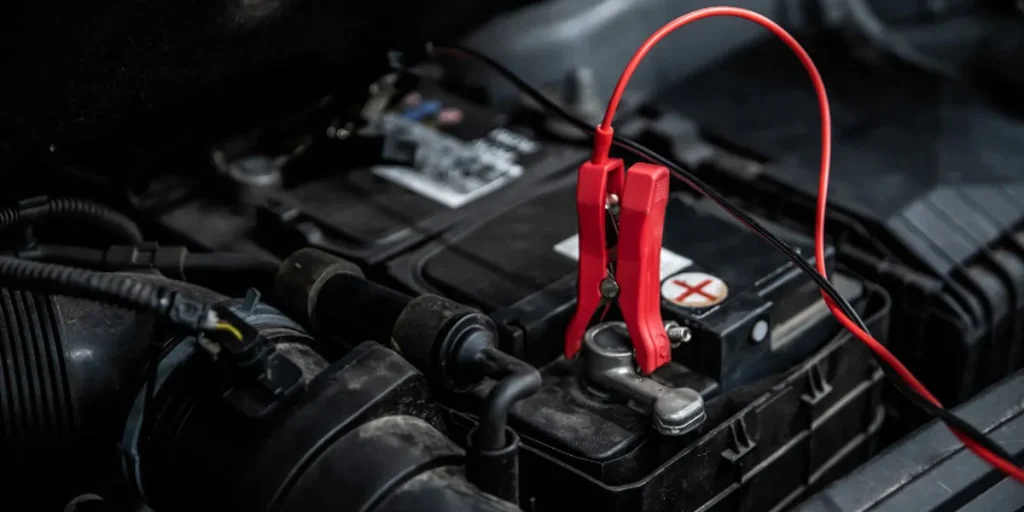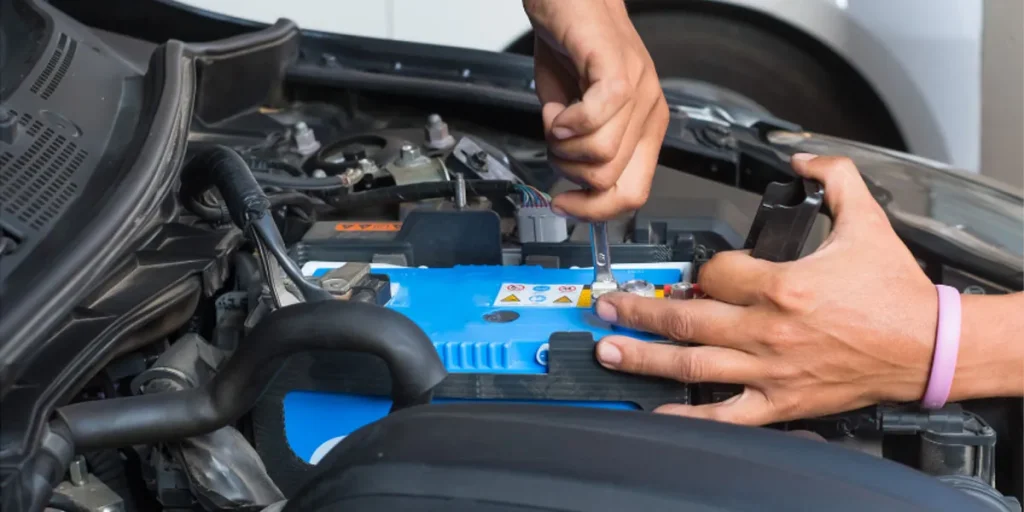Car batteries typically weigh between 30 to 60 pounds (14 to 27 kilograms). The weight varies depending on the type and size of the battery.
Car batteries are essential components of an automotive electrical system, providing the necessary power to start the engine and run electronic accessories when the vehicle’s engine is off.
The lead-acid battery is the most common type found in cars, known for its reliability and efficiency.
These batteries come in various sizes to accommodate different vehicle requirements, influencing their weight.
Start-stop vehicles often require heavier batteries to support the frequent on-off cycle of the engine.
Understanding the weight of your car battery is crucial for safe handling and replacement.
As enthusiasts and professionals work with batteries, it’s imperative to know their weight to prevent injury or damage during installation or maintenance.

Composition Of Car Batteries
Understanding what goes into car batteries helps gauge their weight. These power sources are complex. They consist of various heavy metals and chemicals.
Essential Materials And Components
A standard car battery is a lead-acid battery. It contains numerous elements:
- Lead Plates: They store the electrical charge.
- Sulfuric Acid Solution: This liquid causes a chemical reaction to provide power.
- Plastic Case: It protects the inner contents of the battery.
- Metal Connectors: They conduct electricity from the battery to the car.
- Separator: It divides individual cells within the battery.
- Water: It keeps the acid solution dilute.
The lead is the primary reason car batteries are heavy. Acid and other materials add to this heft.
Variations Between Battery Types
Not all car batteries weigh the same. Their composition varies based on type. Let’s look at a few:
| Battery Type | Materials Used | Average Weight |
|---|---|---|
| Lead-Acid: | Lead, acid, plastic | 40-60 lbs |
| AGM: | Glass mat, lead, acid | 30-50 lbs |
| Lithium-Ion: | Lithium, other lightweight materials | 20-30 lbs |
Lead-acid batteries are the heaviest. AGM (Absorbent Glass Mat) are slightly lighter. Lithium-ion batteries, often found in electric cars, are lighter yet.
Factors Influencing Battery Weight

Understanding what influences the weight of a car battery can be crucial for car owners. The weight isn’t just about heavy lifting during replacement.
It impacts vehicle performance and fuel efficiency. Let’s delve into the elements that play a pivotal role in determining how much a battery tips the scales.
Size And Vehicle Type Compatibility
The size of a car battery and the type of vehicle it’s designed for are primary factors affecting its weight. Here’s a quick breakdown:
- Smaller vehicles typically require lighter batteries.
- Larger vehicles need batteries that pack more power, hence they’re heavier.
This correlation ensures the battery fits snugly and delivers adequate energy for the vehicle’s needs. Here’s a comparison to consider:
| Vehicle Type | Typical Battery Weight |
|---|---|
| Compact Car | 20-30 lbs |
| Sedan | 40-50 lbs |
| SUV/Truck | 50-60 lbs |
Lead Content And Density
Lead content and density are science at play in battery weight. Lead-acid batteries are common and here’s why they’re hefty:
- They contain lead plates and sulfuric acid.
- Lead is dense and heavy, upping the overall weight.
The amount of lead dictates not just weight but also capacity and longevity. Heavier batteries generally offer longer lifespans and better performance, essential for demanding applications.
Average Weights Across Battery Types

Understanding the weight of a car battery is crucial. It can impact vehicle performance. Different types of car batteries have different weights.
This varies widely across models and manufacturers.
Standard Lead-acid Battery Weights
Lead-acid batteries dominate the market. They have a reputation for reliability. These batteries typically weigh between:
- 30 to 50 pounds for smaller vehicles
- Up to 60 pounds for larger vehicles
Various factors affect weight. These include size, capacity, and design.
| Battery Type | Average Weight |
|---|---|
| Compact Car | 40 lbs. |
| Sedan | 45 lbs. |
| SUV/Truck | 60 lbs. |
Advanced Lightweight Alternatives
New technology brings lighter alternatives. Advanced batteries include:
- Lithium-ion
- Absorbent Glass Mat (AGM)
- Enhanced Flooded Batteries (EFB)
These can weigh up to 70% less than standard lead-acid batteries.
| Battery Type | Average Weight Reduction |
|---|---|
| Lithium-ion | Up to 70% |
| AGM | Up to 40% |
| EFB | Up to 30% |
Impact Of Weight On Performance
Car batteries play a crucial role in vehicle operation, with their weight having a significant impact on car performance.
Understanding how the heaviness of a car battery influences various aspects of a vehicle helps in making informed decisions about battery replacement and maintenance.
Battery Weight Vs. Vehicle Efficiency
Car batteries need to balance power and efficiency. Heavy batteries provide more energy but can reduce overall vehicle efficiency.
This balance is vital for optimal performance. Lighter batteries mean better fuel economy, which is important for both traditional and hybrid vehicles.
The battery’s weight affects how the car handles, accelerates, and brakes.
- Light batteries: Improve fuel efficiency, Increase range, Enhance handling
- Heavy batteries: Offer longer life, Greater cranking power, Possible trade-offs
The Trade-offs Of Heavier Batteries
Bigger isn’t always better with car batteries. Heavier units bring trade-offs. They often have a more extended life and increased cranking power, which is vital for cold-weather functionality.
Yet, they can bog down performance, leading to increased fuel consumption.
| Pros | Cons |
|---|---|
| Longer life | Less efficiency |
| Better in cold | Reduced performance |
| High cranking power | Higher fuel use |
Heavier batteries also mean more strain on a vehicle’s structure and suspension over time.
Lighter batteries may require more frequent replacement, but they keep the vehicle nimble and efficient.
It is essential to strike the right balance for your specific driving needs and vehicle type.
Handling And Installation Considerations
Car batteries play a vital role in a vehicle’s operation, yet they are often heavy and unwieldy.
Understanding how to handle and install these batteries properly ensures safety and efficiency. Here are some key considerations to keep in mind.
Safety Measures For Handling Heavy Batteries
Heavy car batteries require careful handling to prevent injuries and accidents. To ensure safety:
- Always use proper lifting techniques, keeping your back straight and lifting with your legs.
- Wear gloves and eye protection to protect against acid and other hazardous substances.
- Ensure the area is clear of obstacles to prevent trips and falls.
- If a battery is too heavy, do not attempt to lift it alone. Seek assistance or use a cart.
Professional Vs. Diy Installation
Deciding between professional or DIY installation is crucial when handling car batteries. Both approaches have their pros and cons:
| Professional Installation | DIY Installation |
|---|---|
| Experts manage the installation process. | Cost saving if you have the right tools and knowledge. |
| Reduced risk of incorrect installation. | Gives hands-on experience with your vehicle. |
| Typically comes with a service warranty. | Freedom to work at your own pace. |
A professional ensures the job is done right, which is especially important if you lack experience or proper tools. Taking the DIY route can be fulfilling and cost-effective, but only if done correctly.
The Future Of Car Batteries
As we gaze into the future of automobiles, car batteries become a central focus.
Technological advancement promises lighter, more efficient energy sources for our vehicles. Let’s explore how the landscape of car batteries is changing.
Trends In Battery Weight Reduction
The quest for lighter car batteries gains momentum each year. Manufacturers aim to find a balance between weight, performance, and range.
- Lighter materials, like lithium-ion, are replacing lead-acid batteries.
- Advanced designs reduce excess material without losing strength.
- Compact cell formats pack more power into less space.
These trends signify a move towards sleeker, lighter electric vehicles.
Innovations In Battery Technology
Battery technology leaps forward with each innovation. Cutting-edge research introduces batteries that are not just light, but also long-lasting and eco-friendly.
| Innovation | Benefits |
|---|---|
| Solid-State Batteries | Higher energy density; reduced fire risk |
| Graphene Batteries | Increased conductivity; faster charging |
| Bio-derived Batteries | Renewable; less environmental impact |
With these advancements, future car batteries will be revolutionary in terms of both weight and functionality, driving us towards a more sustainable future.
FAQs About the Weight of Car Batteries
What Is The Average Weight Of Car Batteries?
Most car batteries weigh between 30 to 50 pounds. Lead-acid batteries, commonly used in cars, are heavy due to lead content. The exact weight varies depending on the battery size and type.
How Does Battery Weight Affect Vehicle Performance?
Heavier batteries can slightly affect a vehicle’s fuel efficiency and acceleration. However, the impact is minimal compared to the total vehicle weight. Manufacturers balance battery weight for optimal vehicle performance.
Can Battery Weight Vary By Car Type?
Yes, battery weight can differ by car type. Electric vehicles (EVs) often have heavier batteries due to larger capacity needs. In contrast, conventional vehicles typically use lighter batteries.
Are Heavier Batteries Better For Cars?
Not necessarily. A heavier battery doesn’t mean better performance. It’s crucial to use the battery type and size recommended by the vehicle’s manufacturer for optimal efficiency and reliability.
Conclusion
Understanding car battery weight is crucial for both maintenance and safety. We’ve explored the factors that influence their mass, from size to chemistry.
With this knowledge, handling or replacing your car battery becomes a simpler, safer task. Remember to dispose of old batteries properly, keeping environmental responsibility in mind.
Drive safely and power up responsibly!
Resources:
https://afdc.energy.gov/vehicles/electric_batteries.html
https://www.tdi.texas.gov/pubs/videoresource/fsvehiclebat.pdf
